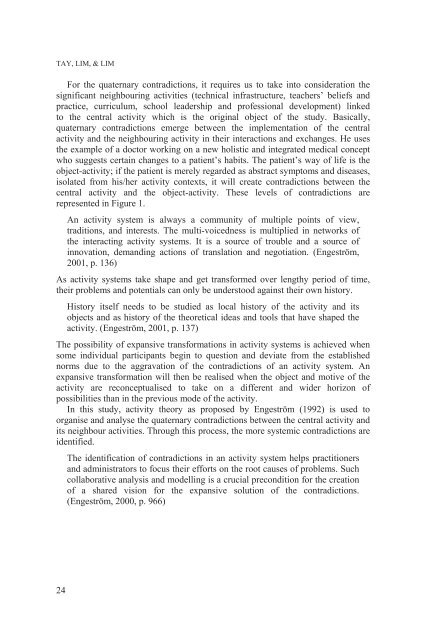1517-creating-holistic-technology-enhanced-learning-experiences
1517-creating-holistic-technology-enhanced-learning-experiences
1517-creating-holistic-technology-enhanced-learning-experiences
Create successful ePaper yourself
Turn your PDF publications into a flip-book with our unique Google optimized e-Paper software.
TAY, LIM, & LIM<br />
For the quaternary contradictions, it requires us to take into consideration the<br />
significant neighbouring activities (technical infrastructure, teachers’ beliefs and<br />
practice, curriculum, school leadership and professional development) linked<br />
to the central activity which is the original object of the study. Basically,<br />
quaternary contradictions emerge between the implementation of the central<br />
activity and the neighbouring activity in their interactions and exchanges. He uses<br />
the example of a doctor working on a new <strong>holistic</strong> and integrated medical concept<br />
who suggests certain changes to a patient’s habits. The patient’s way of life is the<br />
object-activity; if the patient is merely regarded as abstract symptoms and diseases,<br />
isolated from his/her activity contexts, it will create contradictions between the<br />
central activity and the object-activity. These levels of contradictions are<br />
represented in Figure 1.<br />
An activity system is always a community of multiple points of view,<br />
traditions, and interests. The multi-voicedness is multiplied in networks of<br />
the interacting activity systems. It is a source of trouble and a source of<br />
innovation, demanding actions of translation and negotiation. (Engeström,<br />
2001, p. 136)<br />
As activity systems take shape and get transformed over lengthy period of time,<br />
their problems and potentials can only be understood against their own history.<br />
History itself needs to be studied as local history of the activity and its<br />
objects and as history of the theoretical ideas and tools that have shaped the<br />
activity. (Engeström, 2001, p. 137)<br />
The possibility of expansive transformations in activity systems is achieved when<br />
some individual participants begin to question and deviate from the established<br />
norms due to the aggravation of the contradictions of an activity system. An<br />
expansive transformation will then be realised when the object and motive of the<br />
activity are reconceptualised to take on a different and wider horizon of<br />
possibilities than in the previous mode of the activity.<br />
In this study, activity theory as proposed by Engeström (1992) is used to<br />
organise and analyse the quaternary contradictions between the central activity and<br />
its neighbour activities. Through this process, the more systemic contradictions are<br />
identified.<br />
24<br />
The identification of contradictions in an activity system helps practitioners<br />
and administrators to focus their efforts on the root causes of problems. Such<br />
collaborative analysis and modelling is a crucial precondition for the creation<br />
of a shared vision for the expansive solution of the contradictions.<br />
(Engeström, 2000, p. 966)


